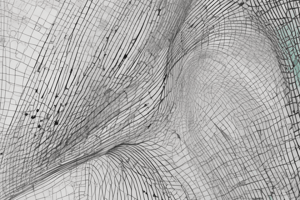Podcast
Questions and Answers
The preimage of point A is located at (4, ______)
The preimage of point A is located at (4, ______)
2
The transformation for point B results in the image at B' with coordinates (______, 5).
The transformation for point B results in the image at B' with coordinates (______, 5).
-6
The vector that represents the transformation is (______, 2) for the y-coordinate.
The vector that represents the transformation is (______, 2) for the y-coordinate.
−4
After the transformation, point D maps to D' at coordinates (______, 1).
After the transformation, point D maps to D' at coordinates (______, 1).
The coordinates of point C' after the mapping are (______, 2).
The coordinates of point C' after the mapping are (______, 2).
The preimage of point B has coordinates (______, 3).
The preimage of point B has coordinates (______, 3).
The transformation rule involves subtracting 4 from the x-coordinate and adding ______ to the y-coordinate.
The transformation rule involves subtracting 4 from the x-coordinate and adding ______ to the y-coordinate.
Point A' is located at the coordinates (______, 4).
Point A' is located at the coordinates (______, 4).
The transformation formula used is (x, y) → (x + 2, y - ______)
The transformation formula used is (x, y) → (x + 2, y - ______)
The image of point A after the transformation is A'(______, 1)
The image of point A after the transformation is A'(______, 1)
Point B has coordinates (______, -3)
Point B has coordinates (______, -3)
After transformation, the coordinates for B' are (6, ______)
After transformation, the coordinates for B' are (6, ______)
Point C is initially located at (______, -2)
Point C is initially located at (______, -2)
The transformed image of point C is C'([-1], ______)
The transformed image of point C is C'([-1], ______)
Point D starts at (-1, ______)
Point D starts at (-1, ______)
The translation vector used in the example is ______, ______.
The translation vector used in the example is ______, ______.
The image of point A(4, -2) after translation becomes point A' ______, ______.
The image of point A(4, -2) after translation becomes point A' ______, ______.
Point B is translated from B(1, -1) to B' ______, ______.
Point B is translated from B(1, -1) to B' ______, ______.
C(-3, 2) transforms into C' ______, ______ after translation.
C(-3, 2) transforms into C' ______, ______ after translation.
The preimage of point A is A(4, -2) and its image after translation is A' ______, ______.
The preimage of point A is A(4, -2) and its image after translation is A' ______, ______.
In vector mapping, the original coordinates (x, y) transform according to the rule (x, y) → ______, ______.
In vector mapping, the original coordinates (x, y) transform according to the rule (x, y) → ______, ______.
Using the translation vector <3, -1>, the new coordinates for point A(-2, 4) will be ______, ______.
Using the translation vector <3, -1>, the new coordinates for point A(-2, 4) will be ______, ______.
The geometric concept being used in the question is known as ______ mapping.
The geometric concept being used in the question is known as ______ mapping.
If a point is at (x, y) and is translated by vector (-2, 5), its new coordinates are ______, ______.
If a point is at (x, y) and is translated by vector (-2, 5), its new coordinates are ______, ______.
In the context of geometry, the process of moving points or figures is called ______.
In the context of geometry, the process of moving points or figures is called ______.
Flashcards
Image
Image
The resulting point or figure after a transformation
Preimage
Preimage
The original point or figure before a transformation
Transformation
Transformation
A change in the position, size, or shape of a figure.
Coordinate Rule
Coordinate Rule
Signup and view all the flashcards
Translation
Translation
Signup and view all the flashcards
Component Form
Component Form
Signup and view all the flashcards
Vector
Vector
Signup and view all the flashcards
Mapping
Mapping
Signup and view all the flashcards
Transformation rule (x,y) → (x+2, y-3)
Transformation rule (x,y) → (x+2, y-3)
Signup and view all the flashcards
Pre-image point
Pre-image point
Signup and view all the flashcards
Image point
Image point
Signup and view all the flashcards
Coordinate change (x, y)
Coordinate change (x, y)
Signup and view all the flashcards
x-coordinate
x-coordinate
Signup and view all the flashcards
y-coordinate
y-coordinate
Signup and view all the flashcards
Translation of a point
Translation of a point
Signup and view all the flashcards
Image of a point
Image of a point
Signup and view all the flashcards
Coordinate Plane
Coordinate Plane
Signup and view all the flashcards
Translation rule
Translation rule
Signup and view all the flashcards
Translation vector <2, 5>
Translation vector <2, 5>
Signup and view all the flashcards
Study Notes
Inverses of Linear Functions
- To find the inverse of a linear function, switch the x and y in the equation.
- First, rewrite the function using a y instead of a function notation.
- Switch the x and the y, and solve for y.
Graphing Inverses
- The inverse of a function is the reflection of the function over the line y = x.
- Graph the inverse of f(x) on the same axes as f(x).
Determining If Two Functions Are Inverses
- Use functional composition to determine if two functions are inverses.
- Show that the function f(x) = 2x - 5 is the inverse of g(x) = (x + 2)/2
- Show that the functions f(x) = x + 6 and g(x) = x - 6 are inverses.
- Show that f(x) = -x + 7 and g(x) = -x - 7 are not inverses.
Graphing Absolute Value Functions
- Understand translations in absolute value functions
- The vertex of f(x) = |x| is (0, 0).
- Given the graph of f(x) = |x|, you can use what you know about horizontal and vertical translations to graph g(x) = |x-h|+k
- The vertex of g(x) is (h,k)
- The slope of the left branch and right branch of f(x) and g(x) is 1
Graphing Transformations of Absolute Value Functions
- The sign of 'a' determines if there is a vertical stretch or vertical compression/reflection
- The slope of g(x) is a for values of x > h and -a for x< h
- The vertex of g(x) = a|x-h| + k is (h, k)
- The slope of the right branch of the absolute value function is 'a'. The slope of the left branch is '-a'
Graphing Linear Inequalities
- Determine the equation for the boundary line.
- Determine the inequality symbol.
- Shade the region that satisfies the inequality.
- Check your results to ensure that a point in the solution region makes the inequality true.
- Check that a point on the boundary line makes the inequality false.
- Draw a dashed line for < or >. Draw a solid line for ≤ or ≥
Linear Inequalities in Two Variables
- Write a linear inequality to describe a given situation.
- Graph the boundary line of the inequality.
- Shade the region that represents the solution set of the inequality.
- Interpret or check the solutions to the inequality.
Vectors and Transformations
- Identify the vector that maps one polygon onto another.
- This includes identifying the preimage and the image.
- Calculate the differences between the vertices/points of the preimage and image.
- Use a table to find the differences.
- Draw the figure with the given vertices.
- Draw the image after a translation by the given vector.
Rotations
-
Find the center of rotation and angle of rotation
-
Draw segments from the center of rotation to corresponding vertices in the preimage and its image.
-
Measure the angle between the segments to determine the angle of rotation.
-
Describe any rotations less than 360° that map the polygon onto itself.
-
Determine the degree of rotation
Studying That Suits You
Use AI to generate personalized quizzes and flashcards to suit your learning preferences.




